The completely wooden Heddal Stave church just outside Notodden Norway gave a good opportunity to test out the capabilities of the D300 at iso 6400. I did bring my tripod with me but for the many day excursions it was a lot easier to just attach the Nikon 18-200mm vr lens and increase the iso to compensate for low light situations.
These Stave churches were built from the early 11th century to the 15th century. At one time there were approximately 800 to 1,000 of these churches built and now only 25 remain. Since these are built entirely of wood many were easily destroyed by fire.
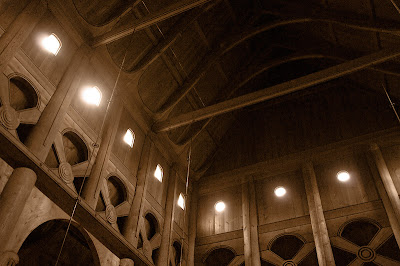
iso 6400, 1/40 sec, f4.5, 24.0mm
This is a view from inside the main chapel. There is no electrical light in the church and it is all lit by the window openings at the top and a few candles near the altar. It is extremely dim inside and a perfect test for the camera capabilities. The metal tubes you see in this image are part of the current sprinkler system to prevent it from being burnt. On the outside along the entire roof sections are other sprinkler nozzles.
Being all wood it was easy to limit the colour noise by de-saturating the colour a bit and then adding a light reddish brown layer set to colour to bring out the warm tones. In Adobe Raw I did set the colour and noise to almost max settings.
Being all wood it was easy to limit the colour noise by de-saturating the colour a bit and then adding a light reddish brown layer set to colour to bring out the warm tones. In Adobe Raw I did set the colour and noise to almost max settings.
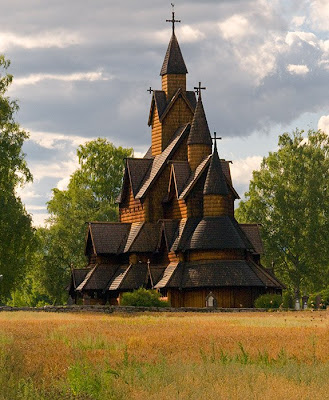
This is the Heddal church, built in the12trh century, is a triple stave church and is now the largest remaining church.
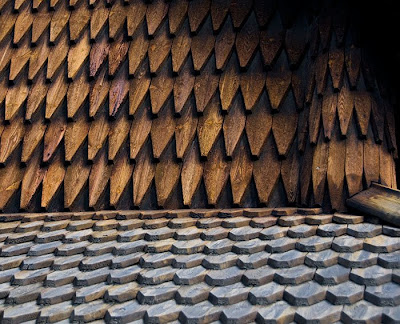
Close-up view of the outside hand cut shingles covering all the roof and wall sections.
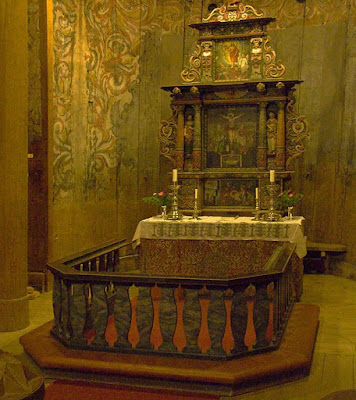
ISO 6400, 1/40 sec, f4.5 , 24.0mm
The above image is of the altar, which is mostly lit by candles and the top window light does not reach into the altar enclave.
iso 6400, 1/20 sec, f4.5, 24.0mm
In the image above you can see the rose painting covering the inside walls. This painting covers some of the more Norse Viking type scenes that originally decorated the walls. It was repainted with the new abstract patterns as the Viking images became out of favour and the Christian teachings and Viking mythology slowly disappeared.
You will notice how the WB has changed from the walls at top being lit by outside light and the post at bottom being lit by candles and therefore a redder tone.

iso 6400, 1/30 sec, f5.0, 24.0mm
Around the bottom of the church is a corridor that runs around the whole of the chapel and there are different doors to go in. This is part of the carvings that surround these giant 10 foot doors.
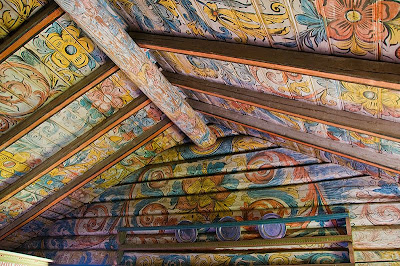
Near the church is a site where they have moved several log cabins as an historic site. You can see the brightly lit rose painting or rosemailing. This is the same as in the church but here we have many windows that provide more light into the interior.

This is a shed on the site but the larger log cabins are built the same method.
You will notice that the log cabin sits on stills and then there is a log split in half and with a flat side on the bottom. This is to prevent rodents from getting into the houses. Note how the steps do not attach to the building, which also keeps them out.
The D300 does a good job of image capture at the higher iso setting of 1600, 3200, and 6400. They are nosier than lower settings but still produce great shots. If you shoot with film and I think the highest was 3200 B&W, these shots would normally not be possible and if you did have very fast film the grain would be very pronounced. I do like the B&W film grain better as the luminance speckles were more random in size and tended to produce better patterns.
You do need to use the luminance and colour noise reduction to improve it. The use of sharpening is not recommended, as it will enhance the noise.
The best method is still to use a tripod and go for longer exposure, but when not possible having an image stabilized lens and high iso, you now are able to get very reasonable images that would not be normally possible.
Niels Henriksen




4 comments:
Thank you for this useful post. Does image stabilization work as good as a tripod in most cases?
I am not sure that image stabilization ever really works as a good tripod. What it does allow you to accomplish is to be able to shoot and lower shutter speeds where handheld camera shake would be a problem.
There is a general rule that the shutter speed should never be slower that the reciprocal of the real focal length. (this includes the crop factor of a digital camera)
As an example if your focal length is 200mm and as with my Nikon I have 1.5 crop factor them the effective focal length is 300mm. Therefore if I have good camera hand holding techniques then the shutter should be no slower than 1/300sec.
Now most lens based camera stabilization system will give you 2, (maybe 2.5 stops) of improvement.
In the example above, then 1 stop would be 1/150s and 2 would be 1/75s.
For landscape scenes or other images that have a lot of fine detail and where you wish to have a large print 13”x 19” or larger, then I would always use a tripod.
Any handheld camera will show camera movement. If the shutter is very fast and you are now moving too much and the focal length is not extreme, then this movement will almost be invisible in the image because it is so small compared to other image elements.
I hope this helps.
Niels Henriksen
Thank you. This helps a great deal.
Oh, my, the photos of the church are stunning. You did such a marvelous job (as always) of sharing it with us.
Post a Comment